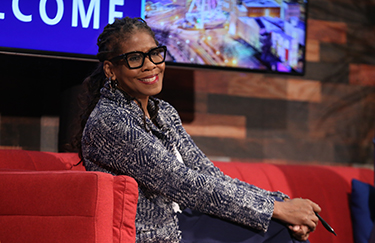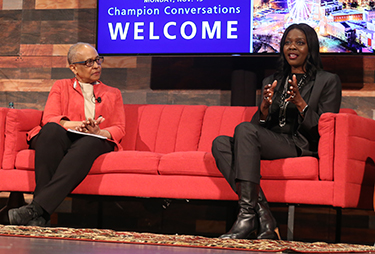Public health professionals from varying backgrounds discussed innovative ways to counter a general lack of inclusion and diversity in research in the featured session “Emerging Issues in Research Equity” at APHA’s 2023 Annual Meeting and Expo.
Diversifying liver disease research and data collection
In the first of three “fireside chats,” APHA President Chris Chanyasulkit sat down with Donna Cryer, CEO and founder of the Global Liver Institute.
Cryer said the topic of liver health is important to her because she was personally affected by liver issues and cancer before having a liver transplant. Cryer made it her mission to improve the quality of care for other patients, which led her to founding the Global Liver Institute nearly 10 years ago.
According to Cryer, the way liver is discussed is important to advancing equity in research and treatment. “We want to shift the conversation from ‘liver disease’ to ‘liver health,’” she said.
With more than 100 known diseases that can affect the liver, it can be hard to get good data — especially data that span a broad population. According to Cryer, the bulk of the research on liver disease comes from Iceland, which is small in geographic area and not very ethnically diverse. She said the only data specific to an ethnic group relate to the Hispanic population, which is known to have a gene that predisposes individuals to fatty liver disease.
Another challenge is that many people may not be aware they have a liver condition. “The research is patchy and often dependent on which disease you’re talking about,” she said. “There’s a lot of hidden disease happening. We know our numbers are skewed because people aren’t being treated.”
Cryer said the Global Liver Institute began using patients’ electronic health records to collect data with their consent. She also mentioned the potential for medical professionals and tech companies to work together, “since Amazon and Google already have so much data on us, including how often we go to the pharmacy.” In addition, there is a “digital divide” between generations. More and more doctors’ offices are switching to electronic records and booking appointments online, which can be daunting for older adults. The Institute helps people learn to navigate their health care in the digital age.
Opioid use disorder studies don’t always get the full picture
 Patricia Harris, CEO and co-founder of eMed, and Rebecca Baker, director of the Helping to End Addiction Long-term program at the National Institutes of Health, discussed their efforts to gather more information on chronic pain, opioid use and addiction among vulnerable populations.
Patricia Harris, CEO and co-founder of eMed, and Rebecca Baker, director of the Helping to End Addiction Long-term program at the National Institutes of Health, discussed their efforts to gather more information on chronic pain, opioid use and addiction among vulnerable populations.
Harris, who has chaired the American Medical Association’s opioid task force since its inception in 2014, said changing research can begin in boardrooms by including a broad array of voices.
“Who you have around decisionmaking tables and executive tables matters. Representation (in research) matters,” she said.
Harris said when she began her role with the AMA’s opioid task force, the data on opioid use disorder were primarily from studies of white, middle- and upper-class individuals who were addicted to prescription opioids. She said people of color got left out of the conversation at the time, even though their communities had been devastated by similar drug use epidemics in the past.
“We had prior opioid epidemics in Black and brown communities — it was called ‘heroin,’ and it didn’t get the attention it deserved,” she said.
Baker said communities of color can have a mistrust of authority and medicine, so it can be difficult to find participants for clinical studies that represent the population currently struggling with addiction. There’s a need to find who is at risk for chronic pain and addiction, she said. That can happen by going into vulnerable communities and talking in a culturally sensitive way to people dealing with pain.
Building partnerships with non-medical professionals is another way to overcome research equity challenges. According to Baker, many people with opioid use disorder have been incarcerated or otherwise involved in the legal system. Therefore, people involved in the legal and prison systems can be a source of information and help tailor local strategies to combat addiction.
Agriculture and nutrition studies can boost health
In the final discussion of the session, Shiriki Kumanyika, with the Drexel University School of Public Health, interviewed Chavonda Jacobs-Young, head of agricultural research with the U.S. Department of Agriculture, to talk about agriculture and food.
Jacobs-Young said food and health are connected and that a healthy diet can prevent cancer and other diseases. Yet, food insecurity is prevalent in America, with 25% of the population facing it — including 9 million children.
One way to gather more relevant information around nutrition is looking at people’s lived experiences with food, including how their culture affects food and nutrition, Jacobs-Young said. The USDA has been involved with African American communities in Baton Rouge, Louisiana; Native American populations in North Dakota; and Hispanic populations in Texas.
“Food is the catalyst that brings people together,” she said.
The average person may not get reliable information around food and nutrition, so the challenge is getting the information out to people who need it most. Another issue surrounding food in the U.S. is a general lack of awareness about where food comes from.
“When you walk into the grocery store, the food doesn’t just appear there,” Jacobs-Young said. “Only 1.5% of the population is growing food for all of us, so if you see a farmer, thank a farmer.”
Photos: Patricia Harris; Shiriki Kumanyika and Chavonda Jacobs-Young. Photos courtesy EZ Event Photography.